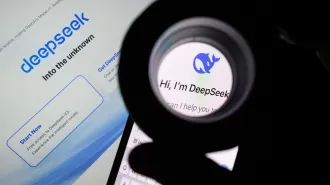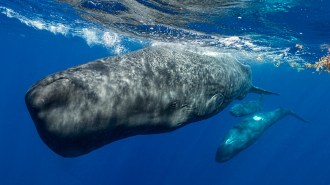Imagine opening the newspaper and seeing a full-color, video clip of a battle or sports match. That’s the sort of vision that drives developers of electronic paper. Even though a black-and-white version that can display static images remains in development, two new approaches offer the prospects of video and bright color.

Electronic paper is a display technology akin to conventional paper but in which the words and images can be changed at will (SN: 6/20/98, p. 396: http://www.sciencenews.org/sn_arc98/6_20_98/bob2.htm). Until now, most developers have rolled out prototypes that rewrite images too slowly for video.
Among many e-paper schemes is that of E-Ink of Cambridge, Mass. The company encloses white and black particles inside an array of liquid-filled microspheres. Electrically controlled spheres collectively serve as a pixel in an image. A voltage across a microsphere induces the particles to migrate in opposite directions so that one face of the sphere becomes black and the other white. Reversing the voltage flips the pixel to the opposite configuration.
In the Sept. 25 Nature, Robert A. Hayes and B. Johan Feenstra of Philips Research in Eindhoven, the Netherlands, describe a new type of e-paper pixel. It looks dark when covered by a thin film of colored oil. But when a voltage sweeps the oil into a corner, a bright white surface appears. Pixels one-quarter millimeter on a side can switch between dark and light in less than 15 milliseconds–fast enough for standard video signals.
By building a more complicated pixel structure that includes filters and multiple oil layers, the researchers have made elements of e-paper that can generate a wide range of colors with exceptional brightness.
Although the display depends on liquid spreading over surfaces, it’s stable against tipping or jarring, notes Hayes. That’s because the fluids are held in place by capillary forces that overpower gravity and other mechanical forces.
Claiming to have already tested the same technology, physicist Joseph M. Jacobson of the Massachusetts Institute of Technology and a cofounder of E-Ink, remarks that the Philips technology harbors a serious flaw: The pixels require continuous power to maintain an image because the oil recoats the pixel surface as soon as the electricity is shut off. Consequently, batteries might run down quickly.
The power issue is a real one, Hayes acknowledges, but it’s most problematic for static images, which last for seconds or longer. He says, “We’re focusing on video-speed applications, where we have to [repeatedly and rapidly] refresh the screen, anyway.”
By next spring, Jacobson says, E-Ink will probably unveil its own full-color e-paper that can change fast enough for video. Unlike the approach that the Philips’ team is taking, the E-Ink technology consumes no power when the image is static, Jacobson says.
Last week at the International Display Research Conference in Phoenix, a Canadian research team reported yet another potential way to achieve color video on e-paper. This one relies on particles that move through a liquid. The distance the particles need to migrate is only a small percentage of the distance required in E-Ink’s microsphere technology. Shorter distances translate into faster switching, a key to creating moving images, says team leader Lorne A. Whitehead of the University of British Columbia in Vancouver.
The video e-paper race is on. Paul S. Drzaic, former director of technology at E-Ink and now with Alien Technology in Morgan Hill, Calif., says that which players come out on top will depend on “how well they solve the problems that always pop up.”
****************
If you have a comment on this article that you would like considered for publication in Science News, send it to editors@sciencenews.org. Please include your name and location.
To subscribe to Science News (print), go to https://www.kable.com/pub/scnw/
subServices.asp.
To sign up for the free weekly e-LETTER from Science News, go to http://www.sciencenews.org/subscribe_form.asp.





